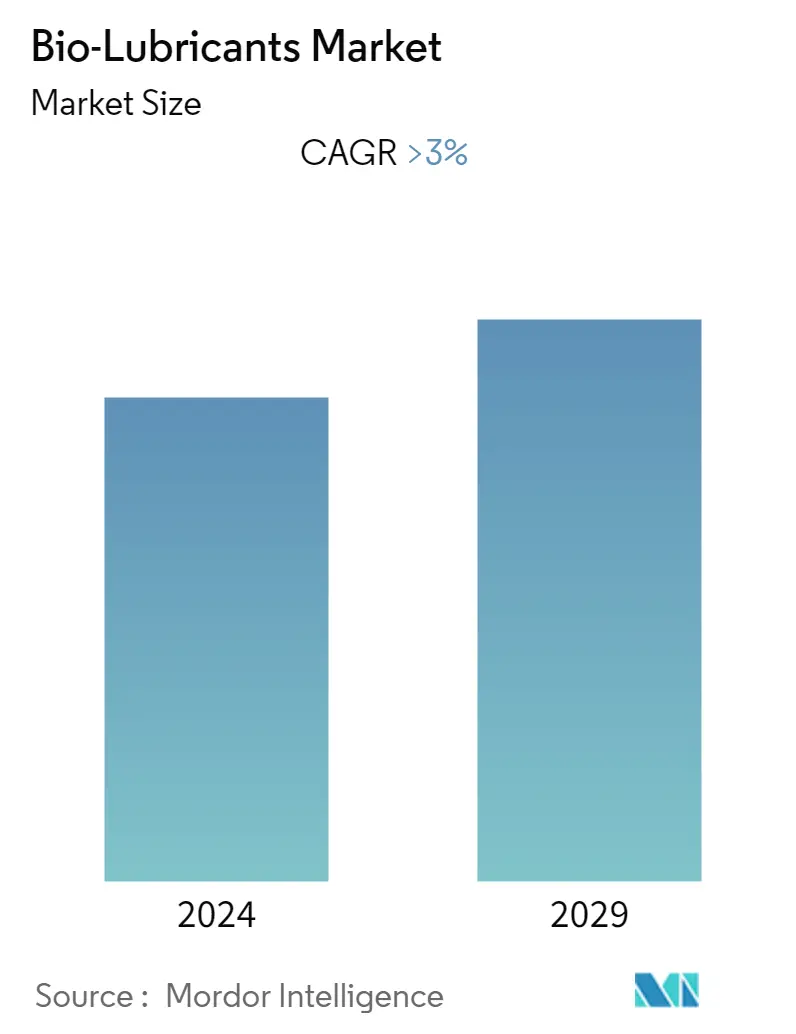Market Size of Bio-Lubricants Industry

| Study Period | 2019 - 2029 |
| Base Year For Estimation | 2023 |
| CAGR | > 3.00 % |
| Fastest Growing Market | Asia Pacific |
| Largest Market | Asia Pacific |
| Market Concentration | Low |
Major Players
*Disclaimer: Major Players sorted in no particular order |
Bio-Lubricants Market Analysis
The bio-lubricants market is projected to register a CAGR of more than 3% during the forecast period.
- COVID-19 negatively impacted the market in 2020. However, the market reached pre-pandemic levels in 2022 and is expected to grow steadily in the future.
- Bio-based lubricants do not cause skin inflammation, which is generally caused by petroleum-based lubricants. Additionally, they have various advantages, such as reduced energy usage, labor costs, increased employee safety, improved environmental conditions, increased machine life, and increased production, thereby augmenting the market's growth.
- Bio-lubricants are produced by esterifying a fatty acid or trans-esterifying vegetable oil. This process is being held with long-chain alcohol in the presence of a homogeneous acid/base catalyst 8 -10 or using an ion-exchange resin. This process increases the cost of bio-based lubricants. This is likely to hinder the market's growth.
- Various R&D projects have been completed to improve the physicochemical properties of bio-based lubricants. These studies have found that bio-lubricants can be used as substitutes for petroleum-based oils and are projected to act as an opportunity for the market.
- The Asia-Pacific region dominated the global market, with the largest consumption from countries such as China, India, and Japan.
Bio-Lubricants Industry Segmentation
Bio-lubricants are functional fluids derived from vegetable oils and esters. Bio-lubricants can help reduce stormwater pollution caused by brake, hydraulic, and engine leaks. They are used in heavy machinery like railroad flanges, chainsaw bars, and two-stroke engines to reduce friction between surfaces because of their eco-friendly and biodegradable properties. Unlike bio-based lubricants, petroleum-based lubricants frequently result in skin irritation.
The bio-lubricants market is segmented by product type, end-user, and geography. By product type, the market is segmented into engine oil, transmission and hydraulic fluid, metalworking fluid, general industrial oil, gear oil, grease, and process oil. By end-user, the market is segmented into power generation, automotive and other transportation, heavy equipment, food and beverage, metallurgy and metalworking, chemical manufacturing, and other end-user industries. The report also covers the market size and forecasts in 15 countries across major regions.
For each segment, the market sizing and forecasts have been done based on revenue (USD million).
| Product Type | |
| Engine Oil | |
| Transmission and Hydraulic Fluid | |
| Metalworking Fluid | |
| General Industrial Oil | |
| Gear Oil | |
| Grease | |
| Process Oil | |
| Other Product Types |
| End-user Industry | |
| Power Generation | |
| Automotive and Other Transportation | |
| Heavy Equipment | |
| Food & Beverage | |
| Metallurgy & Metalworking | |
| Chemical Manufacturing | |
| Other End-user Industries |
| Geography | ||||||||
| ||||||||
| ||||||||
| ||||||||
| ||||||||
|
Bio-Lubricants Market Size Summary
The bio-lubricants market is experiencing a steady growth trajectory, recovering from the setbacks caused by the COVID-19 pandemic. This market is driven by the increasing demand for environmentally friendly alternatives to petroleum-based lubricants, which are known to cause skin inflammation and have other adverse effects. Bio-lubricants offer several advantages, including reduced energy consumption, lower labor costs, enhanced employee safety, and improved environmental conditions. These benefits contribute to the extended lifespan of machinery and increased production efficiency. However, the production process of bio-lubricants, which involves esterifying fatty acids or trans-esterifying vegetable oils, can be cost-prohibitive, potentially hindering market expansion. Despite these challenges, ongoing research and development efforts are focused on enhancing the physicochemical properties of bio-lubricants, positioning them as viable substitutes for traditional oils and presenting significant market opportunities.
The Asia-Pacific region leads the global bio-lubricants market, with substantial consumption in countries like China, India, and Japan. The automotive and transportation sectors are significant contributors to market demand, as these industries seek to improve lubricant performance, energy efficiency, and environmental sustainability. Bio-based lubricants are increasingly used in various applications, including construction, forestry, and nautical machinery, due to their low toxicity and high performance. The expanding automotive sector in China and the growing power generation industry in the region are expected to further drive market growth. Additionally, the fragmented nature of the market sees major players like BP, Chevron, and Exxon Mobil actively engaging in strategic acquisitions and collaborations to enhance their bio-lubricant offerings, supporting the market's development during the forecast period.
Bio-Lubricants Market Size - Table of Contents
-
1. MARKET DYNAMICS
-
1.1 Drivers
-
1.1.1 Regulatory Norms Driving the Demand for Bio-based Lubricants
-
1.1.2 Other Drivers
-
-
1.2 Restraints
-
1.2.1 High Price of Bio-based Lubricants
-
1.2.2 Other Restraints
-
-
1.3 Industry Value-Chain Analysis
-
1.4 Porter's Five Forces Analysis
-
1.4.1 Bargaining Power of Suppliers
-
1.4.2 Bargaining Power of Consumers
-
1.4.3 Threat of New Entrants
-
1.4.4 Threat of Substitute Products and Services
-
1.4.5 Degree of Competition
-
-
-
2. MARKET SEGMENTATION (Market Size in Value)
-
2.1 Product Type
-
2.1.1 Engine Oil
-
2.1.2 Transmission and Hydraulic Fluid
-
2.1.3 Metalworking Fluid
-
2.1.4 General Industrial Oil
-
2.1.5 Gear Oil
-
2.1.6 Grease
-
2.1.7 Process Oil
-
2.1.8 Other Product Types
-
-
2.2 End-user Industry
-
2.2.1 Power Generation
-
2.2.2 Automotive and Other Transportation
-
2.2.3 Heavy Equipment
-
2.2.4 Food & Beverage
-
2.2.5 Metallurgy & Metalworking
-
2.2.6 Chemical Manufacturing
-
2.2.7 Other End-user Industries
-
-
2.3 Geography
-
2.3.1 Asia-Pacific
-
2.3.1.1 China
-
2.3.1.2 India
-
2.3.1.3 Japan
-
2.3.1.4 South Korea
-
2.3.1.5 Rest of Asia-Pacific
-
-
2.3.2 North America
-
2.3.2.1 United States
-
2.3.2.2 Canada
-
2.3.2.3 Mexico
-
2.3.2.4 Rest of North America
-
-
2.3.3 Europe
-
2.3.3.1 Germany
-
2.3.3.2 United Kingdom
-
2.3.3.3 Italy
-
2.3.3.4 France
-
2.3.3.5 Russia
-
2.3.3.6 Rest of Europe
-
-
2.3.4 South America
-
2.3.4.1 Brazil
-
2.3.4.2 Argentina
-
2.3.4.3 Rest of South America
-
-
2.3.5 Middle East & Africa
-
2.3.5.1 Saudi Arabia
-
2.3.5.2 South Africa
-
2.3.5.3 United Arab Emirates
-
2.3.5.4 Rest of Middle East & Africa
-
-
-
Bio-Lubricants Market Size FAQs
What is the current Bio-Lubricants Market size?
The Bio-Lubricants Market is projected to register a CAGR of greater than 3% during the forecast period (2024-2029)
Who are the key players in Bio-Lubricants Market?
Chevron Corporation, TotalEnergies, Exxon Mobil Corporation, BP p.l.c. and FUCHS are the major companies operating in the Bio-Lubricants Market.

